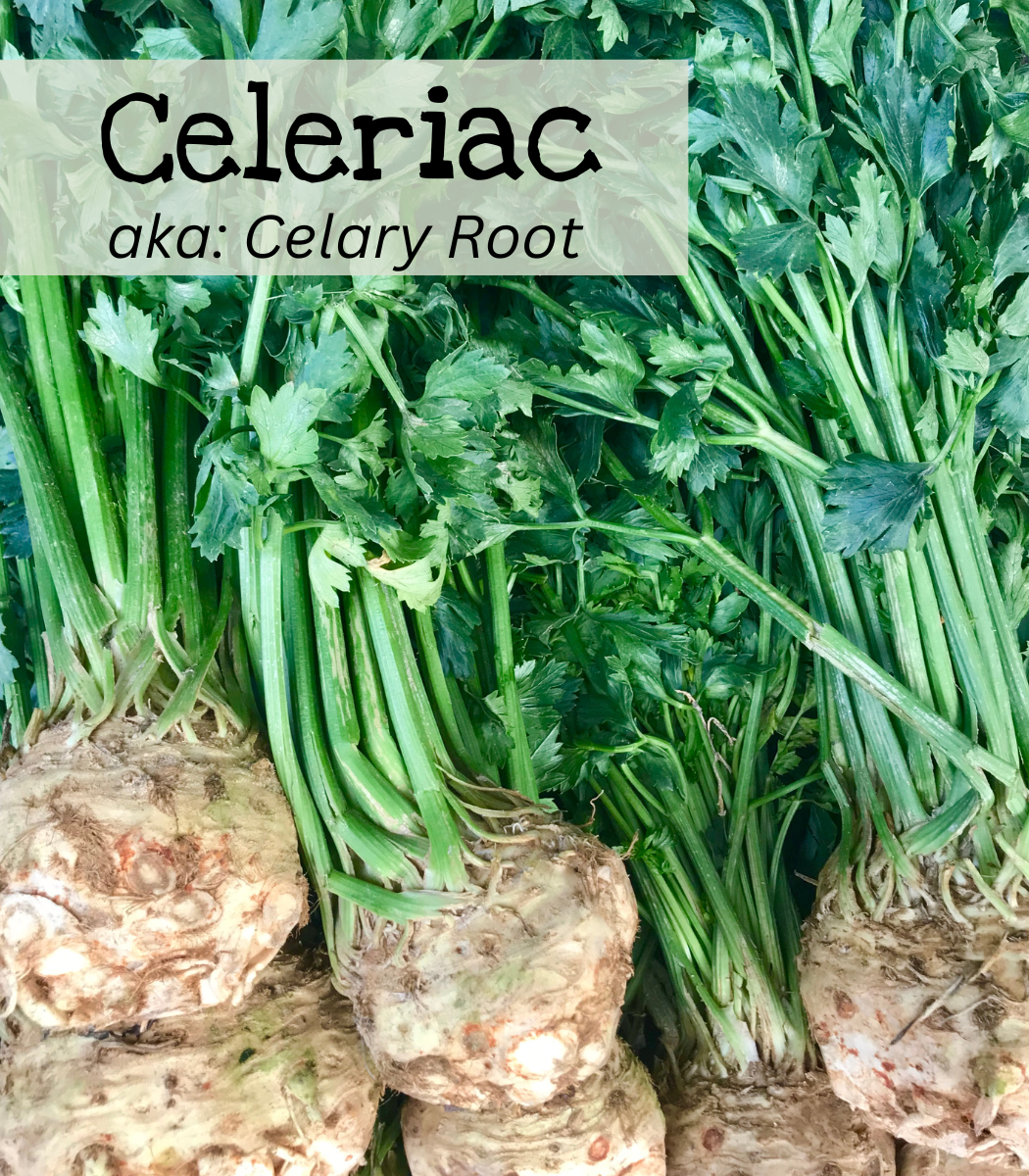
Celeriac
Celeriac, or root celery, differs from celery in that it is grown for its sweet root rather than the stocks. This long-season crop is sown in late winter to early spring and harvested in the fall.
|
Giant Prague |
|
Apium graveloens |
|
Intermediate to Easy |
|
Difficult |
|
5 years |
|
Biennial but treated as an annual |
|
15-20 days |
|
70-75 F |
|
None |
|
Surface Sow |
|
Yes |
|
19-23” x 22-26” |
|
3-5” |
|
Needs light to germinate Full Sun (8-12 hours) |
|
Fall (105-115 days) |
|
February |
|
Yes |

Growing Tips


When to Start
Late Winter to Early Spring: Start indoors 8-12 weeks before the last frost. (Mid-Feb to Early-Mar for Jefferson, GA)
Transplant: After ALL danger of frost has passed. (1 May for Jefferson, GA)
How to Grow
Start seeds indoors 8-12 weeks before the last frost date. Use sterile, pre-moistened seed starting mix. Surface sow the seeds, as they need light to germinate, into cells or seedling pots. Sow several seeds per cell as 50% germination is considered good for Celeriac. Anything you can do to aid germination is good. A heat mat will help keep soil temperatures consistently at celeriac’s preferred germination temperature of 70-75 F. Place the cells or pots under grow lights. Keep in mind they are slow to germinate. Thin to the strongest seedling per cell or pot.
When you start indoors, this is also a good time to start preparing your beds. Celeriac needs a minimum of 8 hours of direct sunlight. A bed that receives anywhere from 8-12 hours is preferred for more northern climates. Southern climates will need a location that receives some afternoon shade. Loosen the soil to a depth of 8 inches to give the roots room to grow. Raised beds might be a good option for anyone with clay soil. You might even be able to get away with growing it in a 5-gallon container.
Re-pot into larger pots once the seedlings are as tall as the pot is deep and when they have at least 3 true leaves. Keep the crown level with the soil when repotting or transplanting. Harden off seedlings before transplanting them outside after the danger of frost has passed. (May 1 for Jefferson, GA) Keep in mind celeriac will bolt prematurely if planted when it is too cool or experiences a cold snap. This is the opposite of what we typically think about. This premature bolting will cause the plant not to produce a large bulb, which is what is harvested.
Care
Celeriac needs a minimum of 8 hours of direct sunlight and a bed that has rich, well-draining soil. Loosen the soil to a depth of 8 inches. Add compost or other organic material when loosening the soil. It likes a soil pH of 6.o-7.0, slightly acidic to neutral.
It also likes consistent moisture throughout the entire growing process. Soaker hoses and mulch will help keep the soil moist and cool. Just keep the mulch away from the swelling bulb.
As it is the blub you are harvesting, you want to encourage good root development. Water slowly and deeply. Give the plants 1-1.5 inches of water a week. But as always, water according to the needs of the plant. Keep the soil moist, but not soggy.
Celeriac is a heavy feeder. It needs good rich soil for large bulb development. Side dress with compost or well-rotted manure several times throughout the growing season.
Celeriacs prefer cooler temperatures and don’t tolerate well hot conditions. This can be a problem in hot southern climates. Choosing a location that receives some afternoon shade or making use of shade cloths will be helpful when temperatures become too hot. This shade will also help prevent celeriac from bolting in hot weather. Just like when exposed to too cool temperatures as seedlings, bolting in hot weather will disrupt bulb development.
Space the plants 8-12 inches apart. To encourage root size, keep the plants well-watered but not soggy. Also, remove any horizontal leaves and branches every couple of weeks or so, leaving enough leaves to keep the plant healthy. This will expose the crown, allowing the blub to swell.
Harvest
Harvest after a light frost. To boost the size of the celeriac, when they are “ready” for harvest, remove any horizontal leaves/branches from the plant. Then using your hand, carefully make a small trench around the root bulb until it is bare. Don’t go too deep. This will stop the bulb from putting out new roots causing it to swell bigger. Then let it grow for around another month.
Dig up the whole plant and remove the roots and tops. Leave it dirty until you are ready to eat it.
Storage
After the tops and roots have been removed leave them dirty. They will store for 2-3 months in a root cellar. They will also keep in the refrigerator for several weeks.
Pest Management
Slugs may be a problem with young seedlings. An eggshell or diatomaceous earth barrier will be helpful in controlling slugs.
Root-knot-nematoids can be a problem for celeriac. These microscopic worms will go after the roots. The plants may appear stunted or wilted. This is a particular problem in the South. Make use of companion planting with marigolds. See Companion Planting for more information.
How to use
Wash and then peel the celeriac. You can chop or shred it for use in soups or salads. It can also be mashed and added to mashed potatoes adding a delicious flavor.
Seed Saving

Isolation Distance
Celeriac is pollinated by insects and varieties should be separated by 1 mile to ensure purity. It is biennial and should produce seeds in the second year.
Instructions
As the plants are biennial, you won’t be harvesting the bulb. You will be sacrificing a harvest to get seeds. The plants need to go through vernalization to trigger the plants to move to seed production. This can happen even in juvenile plants. This is why if you are growing for harvest you don’t want to plant when it is too cool (<50F).
Dig up the plants to store in late fall. Or leave them in the ground to overwinter. If digging them up, trim the tops off and store the roots in a ventilated container. Store at 34F with 75% humidity. A root cellar, garage, or other non-heated place should be good for this. Replant them the following spring.
After they flower, let the flowers completely dry on the plant before harvesting. The seeds should be brown and detach easily. They will need to continue to dry out of direct sunlight for about another week. Then store the seeds in a cool, dry, and dark place.
The recommended number of plants for genetic diversity is 20-50 plants. However, you can save seeds from any number. If saving from less than 20, mix the saved seeds with purchased seeds every few years to keep genetic diversity.
Features
- Giant Prague was introduced in 1871
- The roots are good fried, in soups, or mashed and mixed with mashed potatoes

All plants are designed to continue the species. Bolting is the sign that the plant is at the end of its life cycle and is now focused on producing seeds for propagation. In the case of celeriac, it should produce seeds in the second year as it’s a biennial. However, when temperatures reach the extremes, the plant thinks it’s in danger of dying without having produced seeds and it then becomes focused on propagation. So it puts all its energy into producing seeds, rather than the bulb.
Celeriac will taste better after a light frost. The longer it stays in the soil, the stronger the flavor it will have.
To encourage larger bulbs, remove the horizontal leaves or branches throughout the growing season. Just leave enough leaves to keep the plant healthy.
